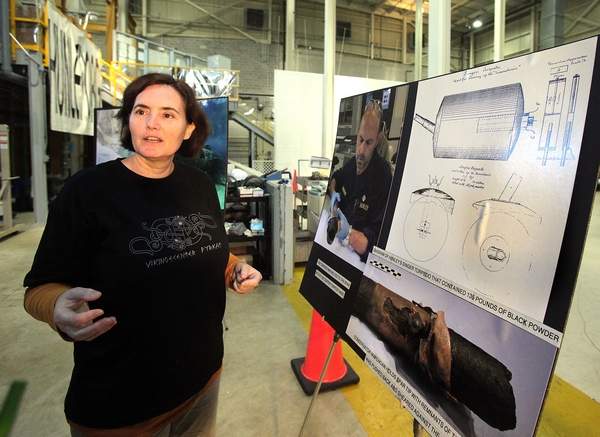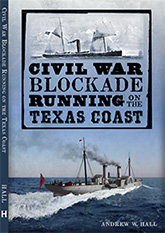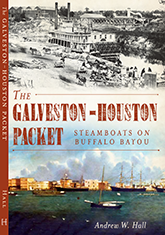The Fate of the Confederate Submersible H. L. Hunley

Big news came out Monday in the investigation of the remains of the Confederate submersible Hunley, arguably the most important scientific finding of the project to date. Archaeologists revealed that the cleaned an conserved remains of the iron spar that carried the boat’s 135 lb. (61kg) torpedo still had attached remnants of the explosive device’s copper casing, peeled back by the force of the explosion (above). This is a tremendously important finding, because it shows that the little “fish boat” was close, very close, the blast that sank her opponent, U.S.S. Housatonic. How close?
Here’s why. Hunley was originally intended to tow a floating mine (then called a “torpedo”) behind her, and run under the target ship. If all went according to plan, the mine would be pulled into the side of the enemy vessel and detonate — on the opposite side from where Hunley was.
Unfortunately, this worked better in theory than in practice. In testing, they found that the towing line was prone to getting fouled in the boat’s propeller and rudder mechanism. Hunley’s ability to dive and run completely submerged — in order to pass underneath the target vessel — was problematic, as well, as shown by two prior, fatal sinking of the boat. (Not for nothing was it known as the “peripatetic coffin.”) Clearly, they had to find a method to deliver the mine to its target that gave them precise control, which in turn meant planting the mine against the target ahead of the boat, not towing it along behind.
![]()
 Hunley Project Chief Archaeologist Maria Jacobsen. Charleston Post & Courier.
Hunley Project Chief Archaeologist Maria Jacobsen. Charleston Post & Courier.
![]()
For years, it’s been generally accepted that Hunley‘s mine was detachable and fitted with a spike or barb, that would be rammed into the target’s hull. Once that was fixed in place, the submersible would back off for a safe distance, and detonate the mine using a lanyard, in the same way that period artillery pieces were fired. Up to today, this was the accepted scenario of how the attack was supposed to have been carried out. The physical evidence revealed in Charleston on Monday, however, suggests that experience gained in another attack on a blockading warship caused a critical change in those plans:
![]()

As a result, the scientists now believe, George Dixon and his crew set out on the evening of February 17, 1864, with the intention of placing the mine not in the enemy ship’s side, but under the hull, anticipating that most of the blast would be directed upward, ripping apart that part of the vessel. This interpretation in supported by witnesses aboard Housatonic, who first sighted Hunley a couple of hundred yards off their port bow, then watched as the submersible passed across their bow, then came around to strike their ship well aft on the starboard side, where the contour of the hull sweeps in and up toward the stern.
That sort of attack, if were planned that way as the researchers now believe, almost certainly doomed Hunley and her crew. Nonetheless, neither the project’s chief archaeologist, Maria Jacobsen, nor South Carolina Lieutenant Governor Glenn McConnell, who’s led the fund-raising for the project since its inception, believe Dixon and his crew expected theirs to be a suicide mission. “They were pressed for time, they were pressed for resources, but nothing indicates this was a suicide mission,” Jacobsen said. “They just had to get the job done.”
![]()
 Detail of a painting, “Charleston Bay and City,” by Conrad Wise Chapman, showing a Confederate ironclad with a spar torpedo (show in raised position) very similar to that used aboard Hunley. Museum of the Confederacy.
Detail of a painting, “Charleston Bay and City,” by Conrad Wise Chapman, showing a Confederate ironclad with a spar torpedo (show in raised position) very similar to that used aboard Hunley. Museum of the Confederacy.
![]()
Lots of questions about what happened that night remain, including ones underscored by Monday’s announcement about the spar torpedo. Though the crew probably had little idea of how the concussion from the detonation of the mine would have carried underwater, the force must have been tremendous. While the hull of the boat itself remains covered for now with cement-like concretions of sand and shell, when these are removed beginning next year, Jacobsen and her team will be looking closely for effects of the blast, in the form of popped rivets and opened seams between the iron plates. It would not take many of these to sink a boat like Hunley, that had precious little buoyancy to begin with, even under ideal conditions. If her crew were incapacitated as well, Hunley could easily have drifted, slowly filling with water, until she settled on the bottom some distance away.
We likely never will know all the details of what happened that night in February 1864, but the work of Jacobsen and her team at the Warren Lasch Conservation Center, where Hunley is being studied and preserved, are getting us closer and giving us a better understanding of those events.
In the meantime, I’ve updated the spar on my old digital model of H. L. Hunley. There’s a spool on the starboard side of the boat, next to the forward hatch. Until it was assumed that this was for unspooling the lanyard used to detonate the mine; now I think it may have led through a block on the upper boom, to raise and lower the spar. That’s how I’ve depicted it here:



Finally, a few good Hunley links for those interested in learning more:
Michael Crisafulli’s Hunley reconstruction:http://www.vernianera.com/Hunley/ Michael likely knows more about the construction and operation of the Hunley than anyone not directly affiliated with the project. Great stuff for the technically-minded. (Michael also can give you a guided tour of Jules Verne’s Nautilus, as well.) NPS Housatonic Site Assessment
http://www.cr.nps.gov/history/online_books/maritime/housatonic.pdf NPS Hunley Site Assessment:
http://www.cr.nps.gov/history/online_books/maritime/hunley.pdf
___________






The forward tower was damaged during the attack. Now we know why.
Watched an installment of this project, maybe the history channel, fascinating. Thanks for the update.
Bummer
There are likely to be many surprising clues to come, with each one asking more questions than giving answers
That’s how it goes.
I’ve seen the Hunley and can’t imagine be willing to sit in that enclosed area and undertake that mission, particularly given that two previous crews drowned.
It occurred to me recently that had the Hunley been found and raised 75 years ago, we likely wouldn’t have been able to learn one-quarter of what we’ve learned now, given how much more advanced our technology is. It probably would have been put out on display and allowed to rust.
Excellent post on this latest discovery, Andy.